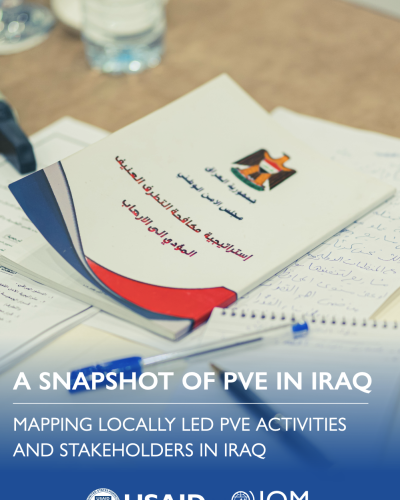A snapshot of PVE in Iraq

EXECUTIVE SUMMARY
The various conflicts Iraq has gone through have created fertile ground for the emergence of violent extremist groups.
Addressing the drivers of violent extremism is essential for achieving long-term peace and security. However, Iraq’s prevention of violent extremism (PVE) shows critical deficiencies, such as the absence of a consolidated mapping of PVE initiatives and stakeholders. To date, attempts to create a consolidated mapping of all stakeholders and their respective PVE initiatives has fallen short. Addressing this gap can significantly enhance the efficacy of future PVE strategies by pinpointing existing patterns, trends and voids in current programmes. This report aims to bridge this information deficit, offering a comprehensive overview of PVE projects and their stakeholders, while also evaluating the merits and limitations of specific PVE interventions such as public spaces, role models and communication campaigns.
First: To address these deficiencies, this report carried out a detailed analysis of 153 PVE projects in Iraq, executed by civil society organizations (CSOs) and government entities, to identify key trends and gaps within a year-long period.
Data indicate a significant emphasis on youth inclusion and social cohesion, representing 44 per cent of the total PVE focus, aligning with international consensus on their importance in PVE. While the government’s efforts towards coordinated PVE activity are commendable, there is a worrying lack of attention towards gender inclusion and economic well-being. These areas remain under-addressed. The modality of PVE interventions leans heavily (60%) on workshops and training sessions, which, despite their value, have drawn criticism for their uniform approach.
Sports-based PVE interventions, though recognized for their effectiveness, account for just 5 per cent of initiatives.
Furthermore, a gap exists in locally led PVE research. Rigorous research studies are predominately commissioned by international donors and are largely implemented by international researchers who possess academic expertise, but might lack the nuanced contextual understanding integral to PVE research. Meanwhile, CSOs rarely conduct PVE studies, opting to rely on experience and observations to guide the implementation of PVE projects. These dynamics underscore a need for a collaborative approach, integrating the methodological rigor of international experts with the realities on the ground and the intimate knowledge held by local organizations, to foster research that is both comprehensive and contextually relevant.
Second: A stakeholder mapping exercise was conducted that involved selecting stakeholders, from CSOs to religious leaders, and assessing their influence on PVE based on relevancy, effectiveness and impact. Key themes that emerged from the research included: Tribes were identified as pivotal, for their deep community ties and dispute-resolution skills, but over-reliance on them might reinforce tribal hierarchies and risk political manipulations. Political parties often exacerbate divisions, hindering PVE. Local CSOs, while vital, face challenges due to increased commercialization and potential political affiliations. Meanwhile, the research showed that volunteer groups, deeply rooted in localities, show promise in PVE, but require professional guidance.
Third: Public spaces – that is, areas designed for gatherings, cultural events and interactions that bind the fabric of society – have been observed as promising tools in promoting peace, unity and social cohesion. However, their effectiveness hinges on accessibility, especially for marginalized groups. However, challenges persist, with resource constraints, changing security dynamics and coordination issues among the top concerns. Moreover, when shaping opinions and guiding behaviours, the deployment of role models is a promising approach. Such role models can be found in every sector, from sports and education to business and media. Their ability to inspire and advocate for values such as tolerance, economic well-being and active community participation makes them invaluable in PVE efforts. Lastly, the digital age has made communication campaigns essential in PVE, as they counter extremist narratives and reinforce messages on governance and youth inclusion. Yet, despite their potential, there is a shortage of systematic design and evaluation studies of such initiatives.






